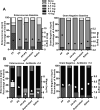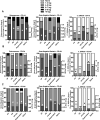Faecalibacterium prausnitzii and a Prebiotic Protect Intestinal Health in a Mouse Model of Antibiotic and Clostridium difficile Exposure
- PMID: 29385239
- PMCID: PMC6068000
- DOI: 10.1002/jpen.1053
Faecalibacterium prausnitzii and a Prebiotic Protect Intestinal Health in a Mouse Model of Antibiotic and Clostridium difficile Exposure
Abstract
Background: Clostridium difficile (CD) infection (CDI) increases patient morbidity, mortality and healthcare costs. Antibiotic treatment induces gut dysbiosis and is both a major risk factor for CD colonization and treatment of CDI. Probiotics have been trialed to support commensal gut microbiota and reduce CDI. This study investigated commensal microbe Faecalibacterium prausnitzii (FP) and a prebiotic, both known to yield butyrate and be anti-inflammatory and immunomodulatory, on CD colonization and gut integrity in mice.
Methods: Mice were randomly grouped and supplemented daily with FP, prebiotic, FP + prebiotic, FP/prebiotic supernatant, or saline throughout the entire study. Following treatment with clindamycin for 3 days, mice were exposed to CD. Feces were collected at baseline, the day after antibiotic, and 1, 3, and 5 days after CD exposure and cultured for bacterial overgrowth and CD colonization. On days 1 and 5 after CD exposure, mice were randomly euthanized, and proximal colon was dissected for histological analysis and preparation of RNA for analysis of proinflammatory and anti-inflammatory cytokines.
Results: Although all mice exhibited bacterial overgrowth and CD colonization, bacterial burden resolved quicker in the FP + prebiotic group. This was associated with induction and resolution of innate immune responses, anion exchanger, and tight junction protein preservation in proximal colon. CD toxin virulence potential was questionable as expression of CD toxin B receptor was depleted in the FP + prebiotic group.
Conclusion: Supplementation with anti-inflammatory butyrate-supporting commensal bacteria and prebiotic may support innate immune responses and minimize bacterial burden and negative effects during antibiotic and CD exposure.
Keywords: antibiotics; butyrate, Clostridium difficile, innate immunity, intestine, microbiome, prebiotic, probiotics.
© 2018 American Society for Parenteral and Enteral Nutrition.
Conflict of interest statement
Conflicts of interest: None declared. The content is solely the responsibility of the authors and does not necessarily represent the official views of the National Institutes of Health.
Figures






Similar articles
-
Disease Progression and Resolution in Rodent Models of Clostridium difficile Infection and Impact of Antitoxin Antibodies and Vancomycin.Antimicrob Agents Chemother. 2016 Oct 21;60(11):6471-6482. doi: 10.1128/AAC.00974-16. Print 2016 Nov. Antimicrob Agents Chemother. 2016. PMID: 27527088 Free PMC article.
-
Impact of Oral Fidaxomicin Administration on the Intestinal Microbiota and Susceptibility to Clostridium difficile Colonization in Mice.Antimicrob Agents Chemother. 2018 Apr 26;62(5):e02112-17. doi: 10.1128/AAC.02112-17. Print 2018 May. Antimicrob Agents Chemother. 2018. PMID: 29463537 Free PMC article.
-
Successional Dynamics in the Gut Microbiome Determine the Success of Clostridium difficile Infection in Adult Pig Models.Front Cell Infect Microbiol. 2019 Aug 6;9:271. doi: 10.3389/fcimb.2019.00271. eCollection 2019. Front Cell Infect Microbiol. 2019. PMID: 31448240 Free PMC article.
-
Clostridium difficile, the Difficult "Kloster" Fuelled by Antibiotics.Curr Microbiol. 2019 Jun;76(6):774-782. doi: 10.1007/s00284-018-1543-8. Epub 2018 Aug 6. Curr Microbiol. 2019. PMID: 30084095 Review.
-
Therapeutic interventions for gut dysbiosis and related disorders in the elderly: antibiotics, probiotics or faecal microbiota transplantation?Benef Microbes. 2017 Apr 26;8(2):179-192. doi: 10.3920/BM2016.0115. Epub 2016 Dec 23. Benef Microbes. 2017. PMID: 28008784 Review.
Cited by
-
Polyphenols and Small Phenolic Acids as Cellular Metabolic Regulators.Curr Issues Mol Biol. 2022 Sep 9;44(9):4152-4166. doi: 10.3390/cimb44090285. Curr Issues Mol Biol. 2022. PMID: 36135197 Free PMC article. Review.
-
Trehalose-Induced Remodelling of the Human Microbiota Affects Clostridioides difficile Infection Outcome in an In Vitro Colonic Model: A Pilot Study.Front Cell Infect Microbiol. 2021 Jul 2;11:670935. doi: 10.3389/fcimb.2021.670935. eCollection 2021. Front Cell Infect Microbiol. 2021. PMID: 34277467 Free PMC article.
-
Akkermansia muciniphila isolated from forest musk deer ameliorates diarrhea in mice via modification of gut microbiota.Animal Model Exp Med. 2025 Feb;8(2):295-306. doi: 10.1002/ame2.12441. Epub 2024 Jun 3. Animal Model Exp Med. 2025. PMID: 38828754 Free PMC article.
-
Next-Generation Probiotics and Their Metabolites in COVID-19.Microorganisms. 2021 Apr 27;9(5):941. doi: 10.3390/microorganisms9050941. Microorganisms. 2021. PMID: 33925715 Free PMC article. Review.
-
Leaky Gut, Leaky Brain?Microorganisms. 2018 Oct 18;6(4):107. doi: 10.3390/microorganisms6040107. Microorganisms. 2018. PMID: 30340384 Free PMC article. Review.
References
-
- Sehulster L, Chinn RYW. Guidelines for environmental infection control in health-care facilities. MMWR Recomm Rep. 2003;52(RR10):1–42. Available from: http://www.cdc.gov/HAI/organisms/cdiff/Cdiff_excerpt.html. - PubMed
-
- Scott KP, Martin JC, Duncan SH, Flint HJ. Prebiotic stimulation of human colonic butyrate-producing bacteria and Bifidobacteria, in vitro. FEMS Microbiol Ecol. 2014;87:30–40. - PubMed
-
- Backhed F, Ley R, Sonnenburg J, Peterson D, Gordon J. Hostbacterial mutualism in the human intestine. Science. 2005;307:1915–1920. - PubMed
Publication types
MeSH terms
Substances
Grants and funding
LinkOut - more resources
Full Text Sources
Other Literature Sources
Medical

